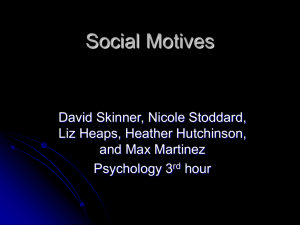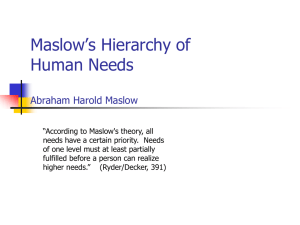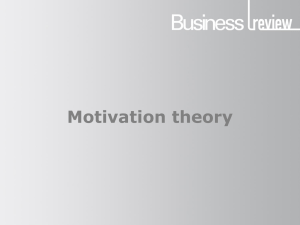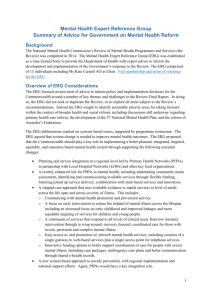File
advertisement
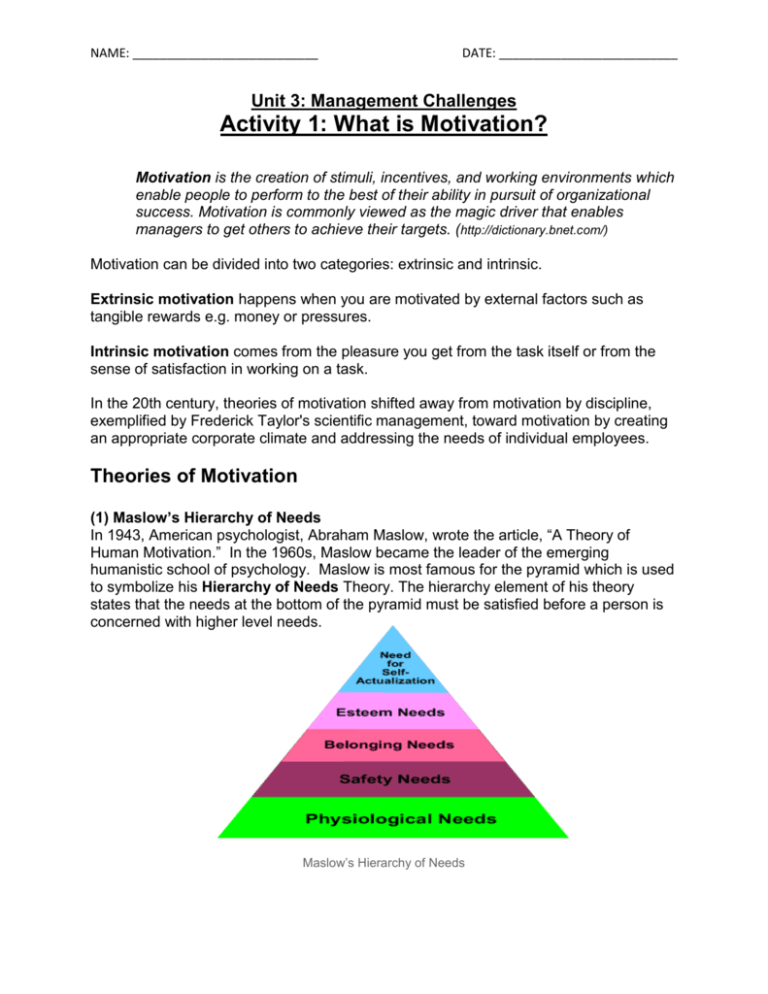
NAME: ___________________________ DATE: __________________________ Unit 3: Management Challenges Activity 1: What is Motivation? Motivation is the creation of stimuli, incentives, and working environments which enable people to perform to the best of their ability in pursuit of organizational success. Motivation is commonly viewed as the magic driver that enables managers to get others to achieve their targets. (http://dictionary.bnet.com/) Motivation can be divided into two categories: extrinsic and intrinsic. Extrinsic motivation happens when you are motivated by external factors such as tangible rewards e.g. money or pressures. Intrinsic motivation comes from the pleasure you get from the task itself or from the sense of satisfaction in working on a task. In the 20th century, theories of motivation shifted away from motivation by discipline, exemplified by Frederick Taylor's scientific management, toward motivation by creating an appropriate corporate climate and addressing the needs of individual employees. Theories of Motivation (1) Maslow’s Hierarchy of Needs In 1943, American psychologist, Abraham Maslow, wrote the article, “A Theory of Human Motivation.” In the 1960s, Maslow became the leader of the emerging humanistic school of psychology. Maslow is most famous for the pyramid which is used to symbolize his Hierarchy of Needs Theory. The hierarchy element of his theory states that the needs at the bottom of the pyramid must be satisfied before a person is concerned with higher level needs. Maslow’s Hierarchy of Needs NAME: ___________________________ DATE: __________________________ Hierarchy need General examples Applications in the workplace Selfactualization creativity, acceptance of facts, lack of prejudice, spontaneous, and morality • creative and challenging work • participation in decision making • job flexibility and autonomy Esteem recognition from others, prestige, status, and selfesteem • responsibility • praise/recognition from boss • promotion to job with more responsibility Belonging acceptance, love, and being part of a group • friendly co-workers • interaction with customers • pleasant supervisor Safety physical security, economic security, and freedom from threats • safe working conditions • job security • base salary and benefits Physiological water, food, sleep, warmth, shelter, and exercise • rest, refreshment breaks • physical comfort on the job • reasonable work hours Adapted from Figure 14.1, page 362, Management Fundamentals, John R. Schermerhorn and Barry Wright, John Wiley and Sons Canada, Ltd, 2007. (2) Alderfer’s ERG Theory In 1969, Clayton Alderfer introduced a theory called the ERG Theory (Existence, Relatedness, and Growth) which aligned to Maslow's Hierarchy of Needs more closely with research. He condensed Maslow’s five needs into three categories. 1. Existence which refers to physiological and safety needs. 2. Relatedness which involves social and external esteem needs, i.e., satisfying personal relationships. 3. Growth which relates self-actualization and internal esteem needs. Like the hierarchy of needs, the ERG Theory also presents a model of progressive needs, e.g., as existence needs are satisfied, relatedness needs become more important. However, unlike Maslow’s theory, the hierarchical aspect of the ERG Theory is not rigid.This flexibility allows the ERG Theory to account for a wider range of observed behaviors, e.g., it can explain the “starving artist” who may place growth needs above existence ones. The ERG Theory also includes a frustration-regression process whereby those who are unable to satisfy a higher need become frustrated and regress to the next lower needs NAME: ___________________________ DATE: __________________________ level. For example, if existence and relatedness needs have been satisfied, but growth need fulfillment is blocked, the individual will become frustrated and relatedness needs will again emerge as the dominant source of motivation. According to ERG, managers must recognize that an employee has multiple needs to satisfy simultaneously. If growth opportunities are not provided to employees, they may regress to relatedness needs. If the manager is able to recognize this situation, then procedures can be set in place to concentrate on relatedness needs until the employee is able to pursue growth needs again. (3) McClelland’s Acquired Needs Theory In the late 1940s, David McClelland’s research identified three needs that he believed important to motivation. His theory involves these three needs; and it states that these needs are acquired or learned during an individual's lifetime. 1. Need for Achievement - This need is the desire to do things well and master tasks. 2. Need for Affiliation - This need is the desire to establish and maintain good relationships. 3. Need for Power - This need is the desire to control or influence other people. What lessons can managers learn from the Acquired Needs Theory? Managers need to appreciate the diversity in how individuals are motivated. By recognizing the strength of each need in the people they manage, they can attempt to create work assignments that are responsive to people’s needs. Managers must understand that workers are often motivated by intrinsic factors, and therefore allowing creativity and innovation on the job will motivate many workers. When intrinsic needs are not met, it can cause workers to revert to extrinsic needs, i.e., pay, working conditions, and vacation. (4) Herzberg’s Two-Factor Theory Herzberg and the Two-Factor Theory In 1959, Frederick Herzberg concluded that job satisfaction and job dissatisfaction are independent factors. His research found that certain factors in the workplace cause job satisfaction, while a separate set of factors cause dissatisfaction. Herzberg’s two factors are: NAME: ___________________________ DATE: __________________________ (1) Motivators/satisfiers which are sources of job satisfaction such as recognition, responsibility, meaningful and interesting work, opportunities for advancement, and personal growth. (2) Hygiene factors which are sources of job dissatisfaction such as working conditions, relationships with co-workers, policies, supervisor behaviour, job security, wages, and benefits. Ensuring that the hygiene factors in a job are all positive is an important first step, but it will not result in people feeling fulfilled or satisfied. In order to experience job satisfaction, they need to experience the motivator factors. Content Theories of Motivation The four theories described above are “content” theories of motivation. Content theories use individual needs to explain people’s attitudes and behaviours at work. These theories support the idea that managers must understand the needs of their workers and establish conditions that allow workers to satisfy important needs through their work. Locke's Goal-setting Theory of Motivation Dr. Edwin A. Locke began to examine Goal-Setting Theory in the mid-1960s and continued researching this idea for thirty years. Locke’s Goal-Setting Theory is derived from Aristotle’s idea that purpose can cause action. Locke researched the impact that goals can have on individual performance. One significant conclusion of goal-setting research is that goals must be challenging and specific if they are going to be effective and increase performance. Performance also depends on goal commitment, i.e., the extent to which a person believes in the goal and is interested in reaching it; and goal acceptance, i.e., the extent to which a person adopts a goal as his/her own. It is best to involve workers in the development of goals. However, workers will respond positively to goals that they didn’t help set if their manager is trusted and adequately supports their efforts to achieve the goals. How do goals affect performance? (1) Goals can lead to greater effort as the individual works harder to meet the goals. (2) Goals can narrow attention and direct efforts to goal-relevant activities. (3) Goals can increase persistence and make people more likely to work through setbacks. Like all theories, the Goal-Setting Theory has its limitations. The goals of a manager and the workers must be aligned with the goals of the organization as a whole. For complex tasks, goal-setting could actually impair performance if the individual becomes preoccupied with meeting the goals, rather than performing tasks. NAME: ___________________________ DATE: __________________________ Check Your Understanding 1. Which of the following is the correct order of needs in Maslow’s Hierarchy of Needs, starting from the bottom of the pyramid? a. b. c. d. Self-actualization, Esteem, Belonging, Safety, and Physiological Esteem, Belonging, Safety, Physiological, and Self-actualization Safety, Esteem, Belonging, Self-actualization, and Physiological Physiological, Safety, Belonging, Esteem, and Self-actualization 2. ERG Theory recognizes that an individual has multiple needs to satisfy simultaneously. Unlike Maslow’s theory, the hierarchical aspect of the ERG theory is not rigid. a. True b. False 3. The needs for Achievement, Affiliation, and Power are the key elements of _________________. a. Maslow’s Hierarchy of Needs b. Alderfer’s ERG Theory c. McClelland’s Acquired Needs Theory d. Goal-Setting Theory

